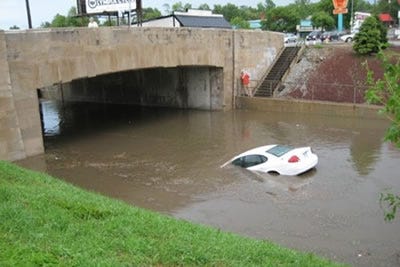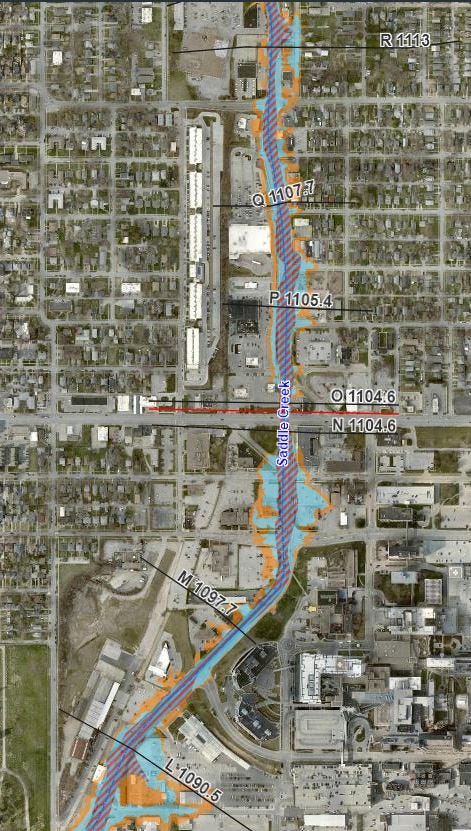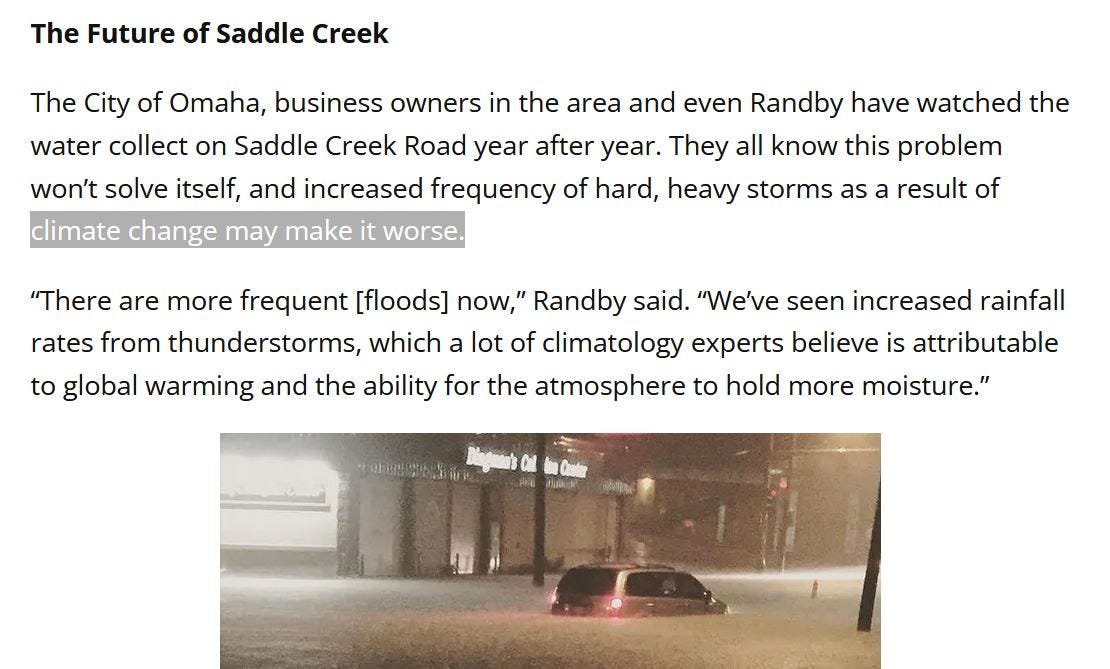Dundee neighborhood residents have been pushing to have Farnam Street made a permanent two-way street, ending the one-way bifurcated system. This has been a story for about 6 years. The change is probably great and innovative at the same time. Add to this fact, the streetcar will likely be built on the much further east parts of Farnam Street. What bothers me is what lies between these elitist projects. Farnam Street connects up with the very problematic Saddle Creek Road.
Farnam becomes a divided street and helps pour water onto Saddle Creek Road during storms. The problem for Saddle Creek road is floods such as the photo below.
The local television news media has covered this from time to time such as in this link.
https://www.wowt.com/video/2021/08/08/omaha-flooding-cars-stuck-saddle-creek/
You would think developers would have had the better sense not to encourage a road at the lowest level of the area but to no avail. Instead, commercial development was encouraged in part because vast parking spaces do not complain about floods. The parking lots actually contributed to more flooding problems.
Today, however, there are apartment buildings and hotels within a block of the flooding area. (https://www.hilton.com/en/hotels/omamcht-home2-suites-omaha-un-medical-ctr-area/ and https://www.dukeomaha.com/) The Duke apartments is a large complex going from California Street and nearly to Dodge Street along 46th Street. This apartment complex replaced the Ready-Mix Concrete plant which used to be located in the spot. This brings more people to the area and why the sorrows of Saddle Creek Road flooding need to be addressed.
I expected the local Natural Resource District (NRD) (https://www.papionrd.org/) to have plans to do something about it. Republican Patrick Bonnett is on this board and so was City Council member Dan Begley (https://www.papionrd.org/board-of-directors/) My latest contact to the NRD to confirm, states no project or plan has been outlined to do something about the area but new information is being reviewed.
The City of Omaha has passed numerous bond issues for sewer and streets which go hand in hand, but no project comes forward for Saddle Creek Road. In addition, residents paying funds to the Metropolitan Utilities District (MUD) find they are paying about $50 a month or about $600 a year for a sewer separation project to keep the fecal matter out of the Missouri River (https://omahacso.com/) Since this is about control of storm water flooding the connecting systems, there should be a plan to do something about controlling flooding during storms along Saddle Creek Road, but no such plan appers to exist.
The Reader did a fairly decent story on the topic and brought the issue to my attention (https://thereader.com/news/saddle-creek-floods-now-fact-of-life-for-locals) However, the story exploited itself for the idiotic man-made climate change theory.
However, the real problem is local government officials rather take on popular projects instead of fixing substantial problems. Skyscrapers, streetcars, a new urban core park, and riverfront development sound so cool. But what if you cannot get there because your car is in the shop due to the latest flood on Saddle Creek Road?








This is an interesting topic up for discussion and further research given the proposed $3.6B expansion of the UNMC Medical Center in that area just east of Saddlecreek.
Currently the creek itself has been previously funneled into an aqueduct under the road and discharges back out into the Papillion Creek leg known as the Big Papio. which is one of four main creek tributaries in the Papillion Creek Watershed. The watershed also has 32 minor tributaries feeding into the creeks.
With continued growth and development, Omaha's population has overwhelmed existing flood control infrastructure and placed a much higher demand on our Storm Water Runoff sewer systems. To alleviate the problem, the Papio-Missouri Natural Resource District has a plan to install a flood control structure designated Damsite 10 upstream from Saddlecreek and is actively completing the engineering phase of the development. As funds become available, the land to develop the proposed damsite will be acquired.
Other alternative plans to control flooding throughout the Metropolitan area are also proceeding well now that FEMA (Federal Emergency Management Agency) has completed its most recent effort to remap the Flood Plain and has released its findings. Our PM-NRD staff of engineers has been analyzing the new data and is working to adjust its area Flood Control and Hazard Mitigation Plans.
As the engineering plan for Damsite 10 begins to near completion, the PM-NRD will again host public meetings for all interested parties, taxpayers, media and other stakeholders in order to share information and receive input. I too am always available for further questions or inquiries from the public.
Best regards!
Patrick Bonnett, Director
Papio-Missouri Natural Resource District
Sub-district 9 in Millard/ S.W. Omaha
Personal Cell: 402-968-7282